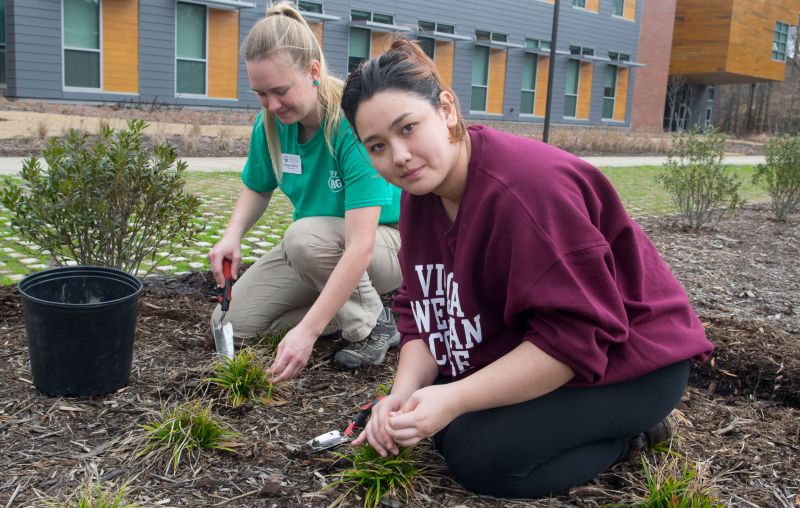Share this Story
Special Care for Living Landscapes
Partnership with Norfolk Botanical Garden provides expertise in maintaining gardens
Featured News | March 2, 2018
by Laynee H. Timlin
 The new Greer Environmental Sciences Center, which opened to students in fall 2017, has many stunning features, including the living landscapes beyond the building. A series of teaching gardens created with native plants inspired by the ecosystems of the Eastern Shore, two upland meadow gardens, three wetland gardens, and a wide variety of different plant species, including trees, shrubs, groundcover, ferns, perennials and aquatic plants surround the exterior of the facility.
The new Greer Environmental Sciences Center, which opened to students in fall 2017, has many stunning features, including the living landscapes beyond the building. A series of teaching gardens created with native plants inspired by the ecosystems of the Eastern Shore, two upland meadow gardens, three wetland gardens, and a wide variety of different plant species, including trees, shrubs, groundcover, ferns, perennials and aquatic plants surround the exterior of the facility.
Maintaining the landscape’s unique teaching gardens and plants requires special attention and expertise. Fortunately, VWU’s partnership with Norfolk Botanical Garden (NBG), which was established last summer, provides just that.
One of the aspects of the multifaceted partnership includes assistance from Norfolk Botanical Garden Horticulturist Maggie Herrick, who works with VWU students in performing the day-to-day maintenance for the landscaping around the center. Herrick is on campus on a regular basis to share her expertise and oversee activities such as weeding, watering, mulching, planting and invasive exotic plant removal. This semester, she is assisted in her work by three VWU students, Monique Ayers '20, Christina Whipple '21 and Christian Roden '21.
“The assistance from the students has been important and I am very appreciative of their work,” says Herrick. “The primary areas we are responsible for are the new plantings surrounding the Greer and the Greer green roof. We're currently working on five different species of Sedge (Carex) and three species of Holly (Ilex) in our landscape, which has more than 60 native plants.”
Last semester, Herrick and the students spent a great deal of time watering, weeding, and mulching. As new plants get established and mature, these activities will become less intensive and the care will shift mostly to pruning and cleaning when necessary, and watering in times of drought. The students have added new plantings, such as a Redbud and more shrubs and herbaceous perennials. During the winter and current semester their focus has been on invasive plant removal, which will be a long-term project.
“We have begun the process in areas close to the Greer and will continue to spread out into the campus woods. Some of the unwelcome plants we are focused on include Japanese Privet, Chinese Privet, Eleagnus, English Ivy, and Oriental Bittersweet. This initiative combined with general clean-up of overgrown and overcrowded areas of the forest edge has kept us very busy so far.”
VWU sophomore Monique Ayers has really enjoyed the experience. She is double majoring in psychology and English and admits that those subjects are not what typically come to mind when talking about horticulture.
“Working with Maggie has been amazing and wonderful,” notes Ayers. “I’ve planted daisies, trees and other plants, and have been a part of making the landscape and environment look beautiful in a natural way. I have learned how to identify weeds and how to identify plants by how their leaves feel or are shaped. It’s been a pleasure.”
Herrick and the students were also able to assist campus club Marlins Go Green for a "Campus Cleanup Day" organized by VWU Senior Mayanni McCourty, who also worked with Herrick last semester. They plan to continue to assist with this initiative in the future.
Through the partnership, both organizations hope to jointly pursue the development of research, educational and outreach programs in the botanical sciences. Future cooperative activities will most likely include educational activities and research, as well as, internships for students at NBG.
Norfolk Botanical Garden, a Virginia Historic Landmark that is listed on the National Register of Historic Places, is a non-profit museum for plants with a mission to enrich life by promoting the enjoyment of plants and the environment through beautiful gardens and educational programs.

